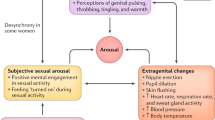Abstract
Physiological and subjective patterns of sexual arousal were compared for sexually functional and dysfunctional women. Previous studies revealed seemingly contradictory findings: Some found significant group differences on physiological but not on subjective responses to erotic stimuli, whereas others found the opposite. To reconcile this discrepancy, subjects were presented with edited versions of the three erotic videotapes used in previous studies. Sexual arousal was measured physiologically with a vaginal photoplethysmograph, and subjectively with a self-report rating scale. Previous methodology was systematically replicated and extended by developing alternate physiological data collection and reduction techniques, employing alternate methods of subjective assessment, evaluating the arousal-eliciting capacity of the erotic stimuli, and designing scripts to reduce social demand. Results indicated that dysfunctional women exhibited significantly less physiological and subjectively experienced sexual arousal than functional women in all three stimulus conditions. Dysfunctional women also reported significantly less autonomic arousal. Results (i) replicate several seemingly contradictory findings in the literature, (ii) reconcile and provide evidence supporting an explanation for the apparent discrepancy, and (iii) reveal that subjective experience and genital vasocongestion are two primary components of sexual arousal that reliably discriminate dysfunctional from functional patterns of sexual response in women.
Similar content being viewed by others
References
Beck, J. G., Sakheim, D. K., and Barlow, D. H. (1983). Operating characteristics of the vaginal photoplethysmograph: Some implications for its use.Arch. Sex. Behav. 12: 43–58.
Derogatis, L. R. (1975).The Brief Symptom Inventory, Clinical Psychometrics Research, Baltimore, MD.
Derogatis, L. R. (1978).Derogatis Sexual Functioning Inventory, rev. ed., Clinical Psychometrics Research, Baltimore, MD.
Derogatis, L. R., and Melisaratos, N. (1979). The DSFI: A multidimensional measure of sexual functioning.J. Sex Marital Ther. 5: 244–281.
Derogatis, L. R., and Meyer, J. K. (1979). A psychological profile of the sexual dysfunctions.Arch. Sex. Behav. 8: 201–223.
Heiman, J. R. (1977). A psychophysiological exploration of sexual arousal patterns in females and males.Psychophysiology 14: 266–274.
Heiman, J. R., and Hatch, J. P. (1980). Affective and physiological dimensions of male sexual response to erotica and fantasy.Basic Appl. Soc. Psychol. 1: 315–327.
Heiman, J. R., and Rowland, D. L. (1983). Affective and physiological sexual response patterns: The effects of instructions on sexually functional and dysfunctional men.J. Psychosom. Res. 27: 105–116.
Laboratory Technologies Corporation. (1986).Labtech Notebook, Version 4.0 [Computer program], Wilmington, MA.
Morokoff, P. J., and Heiman, J. R. (1980). Effects of erotic stimuli on sexually functional and dysfunctional women: Multiple measures before and after sex therapy.Behav. Res. Ther. 18: 127–137.
O'Brien, R. G., and Kaiser, M. K. (1985). MANOVA method for analyzing repeated measures designs: An extensive primer.Psychol. Bull. 97: 316–333.
Olson, C. L. (1976). On choosing a test statistic in multivariate analysis of variance.Psychol. Bull. 83: 579–586.
Palace, E. M., and Gorzalka, B. B. (1990). The enhancing effects of anxiety on arousal in sexually dysfunctional and functional women.J. Abn. Psychol. 99: 403–411.
Rachman, S., and Hodgson, R. (1974). Synchrony and desynchrony in fear and avoidance.Behav. Res. Ther. 12: 311–318.
Rosen, R. C., and Beck, J. G. (1988).Patterns of Sexual Arousal: Psychophysiological Processes and Clinical Applications, Guilford, New York.
Sintchak, G., and Geer, J. H. (1975). A vaginal plethysmograph system.Psychophysiology 12: 113–115.
Steinman, D. L., Wincze, J. P., Sakheim, D. K., Barlow, D. H., and Mavissakalian, M. (1981). A comparison of male and female patterns of sexual arousal.Arch. Sex. Behav. 10: 529–547.
Wincze, J. P., Hoon, E. F., and Hoon, P. W. (1976). Physiological responsivity of normal and sexually dysfunctional women during erotic stimulus exposure.J. Psychosom. Res. 20: 445–451.
Author information
Authors and Affiliations
Additional information
This research was supported by a University of British Columbia Killam Fellowship to Eileen M. Palace and a University of British Columbia Humanities and Social Sciences Grant to Boris Gorzalka.
Temporary address (until 9-1-92)
Rights and permissions
About this article
Cite this article
Palace, E.M., Gorzalka, B.B. Differential patterns of arousal in sexually functional and dysfunctional women: Physiological and subjective components of sexual response. Arch Sex Behav 21, 135–159 (1992). https://doi.org/10.1007/BF01542590
Issue Date:
DOI: https://doi.org/10.1007/BF01542590




